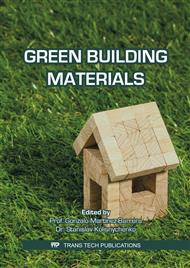[1]
Low, E. T. L., Jayanthi, N., Chan, K. L., Sanusi, N. S. N. M., Halim, M. A. A., Rosli, R., ... & Singh, R. (2017). The oil palm genome revolution. Journal of Oil Palm Research, 29(4), 456-468.
DOI: 10.21894/jopr.2017.00018
Google Scholar
[2]
Henderson, K., & Shorette, K. (2017). Environmentalism in the periphery: Institutional embeddedness and deforestation among fifteen palm oil producers, 1990–2012. Journal of World-Systems Research, 23(2), 269-297.
DOI: 10.5195/jwsr.2017.699
Google Scholar
[3]
Kamyab, H., Chelliapan, S., Din, M. F. M., Rezania, S., Khademi, T., & Kumar, A. (2018). Palm oil mill effluent as an environmental pollutant. Palm Oil, 13.
DOI: 10.5772/intechopen.75811
Google Scholar
[4]
Abdul Hadi, N., Hawari, Y., Ngatiman, M., Jalani, N. F., Wahab, N. A., & Halim, R. M. (2019). Assessment of the effluent polishing plant using an ultrafiltration membrane installed at a palm oil mill. Environment Protection Engineering, 45(1).
DOI: 10.37190/epe190112
Google Scholar
[5]
Iskandar, M. J., Baharum, A., Anuar, F. H., & Othaman, R. (2018). The palm oil industry in South East Asia and the effluent treatment technology—A review. Environmental Technology & Innovation, 9, 169-185.
DOI: 10.1016/j.eti.2017.11.003
Google Scholar
[6]
Ahmad, A., Buang, A., & Bhat, A. H. (2016). Renewable and sustainable bioenergy production from microalgal co-cultivation with palm oil mill effluent (POME): a review. Renewable and Sustainable Energy Reviews, 65, 214-234.
DOI: 10.1016/j.rser.2016.06.084
Google Scholar
[7]
Bala, J. D., Lalung, J., Ismail, N., Palm Oil Mill Effluent (POME) Treatment 'Microbial Communities in an Anaerobic Digester',: A Review. (2016). International Journal of Scientific and Research Publications, 4(6).
Google Scholar
[8]
Kamarudin, K. F., Tao, D. G., Yaakob, Z., Takriff, M. S., Rahaman, M. S. A., & Salihon, J. (2015). A review on wastewater treatment and microalgal by-product production with a prospect of palm oil mill effluent (POME) utilization for algae. Der Pharma Chemica, 7(7), 73-89.
DOI: 10.1016/j.ijhydene.2015.12.010
Google Scholar
[9]
Abd Aziz, M. A., Hazlan, H., Faten Ahada, M. A., (2015). Treatment of palm oil mill effluent (POME) using membrane bioreactor. Malaysian Journal of Analytical Sciences, 19(3), 463-471.
Google Scholar
[10]
Tanpure, P., Shinde, P., Borade, A., Chate, R., Kalje, C., & Gaikwad, D. (2017). Manufacturing of bricks from sewage sludge and waste materials. Imperial Journal of Interdisciplinary Research, 3(5), 1910-1912.
Google Scholar
[11]
Islam, S. M. D.-U. (2017). Electrocoagulation (EC) technology for wastewater treatment and pollutants removal. Sustainable Water Resources Management, 5(1), 359-380.
DOI: 10.1007/s40899-017-0152-1
Google Scholar
[12]
Zaied, B. K., Rashid, M., Nasrullah, M., Zularisam, A. W., Pant, D., & Singh, L. (2020). A comprehensive review of contaminants removal from pharmaceutical wastewater by electrocoagulation process. Science of The Total Environment, 138095.
DOI: 10.1016/j.scitotenv.2020.138095
Google Scholar
[13]
Omwene, P.I.; Kobya, M. (2018). Treatment of Domestic Wastewater Phosphate by Electrocoagulation Using Fe and Al Electrodes: A Comparative Study. Process Safety and Environmental Protection, Volume 116, 34-51.
DOI: 10.1016/j.psep.2018.01.005
Google Scholar
[14]
Rusdianasari, R., Taqwa, A., Jaksen, J., & Syakdani, A. (2017). Treatment optimization of electrocoagulation (EC) in purifying palm oil mill effluents (POMEs). Journal of Engineering and Technological Sciences, 49(5), 604-616.
DOI: 10.5614/j.eng.technol.sci.2017.49.5.4
Google Scholar
[15]
Saenz, N., Sebastián, E., & Cultrone, G. (2019). Analysis of tempered bricks: from raw material and additives to fired bricks for use in construction and heritage conservation. European Journal of Mineralogy, 31(2), 301-312.
DOI: 10.1127/ejm/2019/0031-2832
Google Scholar
[16]
Debnath, A., Salma, M. M., Islam, M. S., Mostafa, M. G., Samad, A., & Akhtar, U. S. (2019). Effect of processed rice husk ash on the production of Conventional bricks.
DOI: 10.14299/ijser.2019.06.04
Google Scholar
[17]
Scinduja, M., Nathiya, S., Shudesamithronn, C. V., Balaji, M. H., Sarathivelan, T., & Pradeep, S. J. (2014). Innovative Brick Material. International Journal for Research in Applied Science & Engineering Technology (IJRASET) Special Issue-1, ISSN, 2321-9653.
Google Scholar
[18]
Dhanalaxmi, B., Sujatha, KN & Rakesh Reddy, E. (2019). Utilization of Solid Waste to Produce Eco-Friendly Bricks. International Journal of Innovative Technology and Exploring Engineering, ISSN, 2278-3075.
Google Scholar
[19]
Amsayazhi, P., & Mohan, K. S. R. (2018). Use of Sludge Waste as Ingredient in Making of Brick. International Journal of Engineering & Technology, 7(3.12), 419.
DOI: 10.14419/ijet.v7i3.12.16120
Google Scholar
[20]
Tharini, R. R., Panchavarnam, K., Jayalakshmi, M. (2018). An experimental study on the behaviour of brick using ball clay, fly ash and jiggery—International Journal of Pure and Applied Mathematics.
Google Scholar
[21]
Coletti, C., Maritan, L., Cultrone, G., & Mazzoli, C. (2016). Use of industrial ceramic sludge in brick production: Effect on aesthetic quality and physical properties. Construction and Building Materials, 124, 219-227.
DOI: 10.1016/j.conbuildmat.2016.07.096
Google Scholar
[22]
Malaysia, J. K. R. (2014). Standard Specification for Building Works. Jabatan Kerja Raya Malaysia. D1-D39.
Google Scholar
[23]
Kasmuri, N., & Tarmizi, N.A. (2018). The Treatment of Landfill Leachate by Electrocoagulation to Reduce Heavy Metals and Ammonia-Nitrogen. International journal of engineering and technology, 7, 109-112.
DOI: 10.14419/ijet.v7i3.11.15940
Google Scholar
[24]
Chambers, P. (2019). Standard Methods for the Examination of Water and Wastewater. Scientific e-Resources.
Google Scholar
[25]
Krishnapriya, G., & Hameed, A. A. (2019). Experimental Investigation Of Self Compacting Concrete With Sisal Fiber.
Google Scholar
[26]
Harish, B.A., Hanumesh, B.M., Siddesh, T.M. & Sidhhalingesh B. K. (2016). An Experimental Investigation on Partial Replacement of Cement by Glass Powder in Concrete. International Research Journal of Engineering and Technology.
Google Scholar
[27]
Shrivastava, A. (2018). Plastic Properties and Testing. Introduction to Plastics Engineering. (2018).
Google Scholar
[28]
Malaysia, D. O. E. (2010). Environmental requirements: a guide for investors.".
Google Scholar
[29]
Lang, L., Chen, B., & Pan, Y. (2020). Engineering properties evaluation of unfired sludge bricks solidified by cement-fly ash-lime admixed nano-SiO2 under compaction forming technology. Construction and Building Materials, 259, 119879.
DOI: 10.1016/j.conbuildmat.2020.119879
Google Scholar
[30]
Prabhu, P., Ramesh, S., & Archana, M. (2019). An Experimental Study on Bricks by Partial Replacement of Bagasse Ash. International Research Journal of Multidisciplinary Technovation, 1(6), 258-265.
DOI: 10.34256/irjmtcon35
Google Scholar



